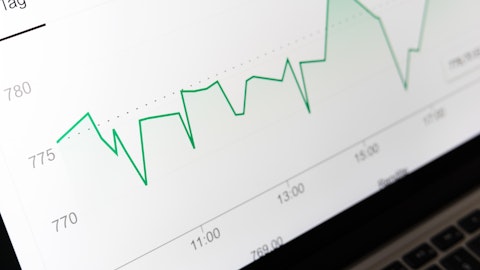Paul Ginocchio: Sure, Allen. As we stand today, the vast majority of our revenue is still delivered by Augmedix Live, our legacy historical premium product. So that’s still a human loop. We have an MDS that works with a clinician. So we moved — as we’ve grown, we’ve moved to a bigger office location in Dhaka in Bangladesh, and we are sunsetting the old building that we’ve been in since, I think, 2018, maybe 2017. And so we’ve got a few months of duplicate costs there, rent, transportation, food, so we’re running that for two buildings. We’ve also in India optimizing our service delivery to make sure we have the highest quality service at the best price. And so we’re doing that. And there’s going to be about three months of overlap that will end in early May around that initiative. And those two things combined are basically the entire decline in gross margin quarter-on-quarter.
Allen Klee: Okay, thank you very much.
Operator: Our next question comes from the line of Yuan Zhi with B. Riley Securities. Please proceed with your question.
Yuan Zhi: Many congrats on the launch of Go, and it’s great to hear they can save up to one hour for the doctors. So can you talk about some of the enhancements you recently added to Go in the ambulatory setting, and will those enhancements be also added to the ER setting as well, particularly doctors are facing a non-linear workflow in the emergency room setting?
Manny Krakaris: Right. So we’re always enhancing our products. We’ve been releasing new features and enhancements to Go almost on a weekly basis at this point. And so there are too many to recount now. But they’re all designed to improve the user experience and to deliver greater utility to the health care enterprise. And you’re right to point out that the products are designed differently between the clinical setting and the acute care setting. For the emergency department, you have a different section in the medical note that you had to create from scratch. It’s called the MDM, which is essentially the medical decision-making that’s occurring in the emergency room. And that is not part of the standard note format for the clinical visit.
So we had to design that. We had to get input from EHR data that comes in, in the form of labs and so forth. We had to be able to input those into the application as close to real time as possible so that the clinician knows at any given moment the updated status of a patient so that they know when to return back to that patient to resume their encounter in the emergency department. So these are some of the things that we’ve been doing. We keep adding to the feature set for each product as we iterate and get feedback from our customers.
Paul Ginocchio: Remember one of the biggest enhancements we’ve made since we launched Go over the last six months is continuing to add additional specialties. As you heard Manny say, we now service 50 specialties. We’ll continue to go deeper in a few key specialties, but Go now supports over 50 specialties. That’s been a big enhancement over the last four or five months.
Manny Krakaris: Right. And we just released that a little over a week ago.
Yuan Zhi: Got it. That’s very helpful. Additional color there. Maybe one last one from me. Can you clarify the difference between Go Assist, the premier version versus the Notes, such as the level of involvement from medical documents specialist or AI contribution?
Manny Krakaris: In terms of the workflow and the utility, there’s very little difference. However, Notes will be sunset and it will be replaced by Go Assist. And the reason for that is we want to provide our customers with a seamless experience, allowing them to transition from one to the other on demand as they need it. If you have two independent applications, it’s more laborious to go from one app to another. So we wanted to eliminate that duality and just have it appear in one seamless range of service that you get from one application.
Yuan Zhi: Got it. That’s all from us. Thank you.
Manny Krakaris: You’re welcome. Thank you, Yuan.
Operator: Our next question is a follow-up question from the line of Allen Klee with Maxim Group. Please proceed with your question.
Allen Klee: Yes, hi. For the $9 million of incremental spending from the capital raised, is it fair to assume that it’s going to take longer to deploy it all and hiring and different things, so that should grow kind of incrementally as we go throughout the year rather than straight line?
Paul Ginocchio: Yeah. Allen, one, we have done a really good job. The team here has done a great job of — as soon as we made the decision to raise capital, we started opening some hiring process. So we were able to get a little bit ahead of it, but obviously not start until we had raised the capital. The team has done a great job of hitting the goals. Obviously, we’re hiring quite a few people. So I think we’re — as Manny said, two-thirds of that hiring is already complete. With more people coming on, we made some approvals today. We have done some projects here in the first quarter. So I’d say we’re fully — it’s going to be fully reflected here in the second quarter, with a lot of it reflected in the first.
Allen Klee: Thank you.
Operator: Our next question comes from the line of Bill Sutherland with The Benchmark Company. Please proceed with your question.
William Sutherland: Thanks. Hey, guys. Hey, Manny, I just have a product question. I haven’t heard about Augmedix Prep in a while. I didn’t know if that became a significant product for you guys.




